Summary of January itinerary in Japan (Yamagata trip)
I traveled to Yamagata prefecture (Tohoku region) from January 25th (Tuesday) to January 28th (Friday). On this trip, I was able to eat a lot of seasonal fish and shellfish and local dishes, and I was able to visit wonderful tourist destinations such as the national treasure and national important cultural properties. Although it was a trip within the same prefecture, Yamagata Prefecture had different cultures and food cultures depending on the region, so it was a very satisfying trip. This is the January itinerary in Japan that I highly recommend to everyone. In addition, I will report a summary of this trip and some notes.
Table of contents
1.”100 selections of local dishes” and “Local dishes loved by the nation” by this itinerary in Japan
2. Seasonal “PRIDE FISH” eaten in this Japanese itinerary
3. Travel precautions (local trains) for itinerary in Japan
6. January 26 (Wednesday) Day 2
7. January 27 (Thursday) Day 3
As I repeat every time, this itinerary was also created with the purpose of “eating out seasonal fish and shellfish and local dishes.” Food is the highest priority, and tourist destinations are the second priority. However, I aimed to visit as many tourist spots as possible, such as national treasures and national important cultural properties. This trip had no effect on snow transportation, and I was able to travel according to the itinerary I created in advance. However, when traveling in Yamagata Prefecture in winter, it is recommended to travel slowly with plenty of time.
1.”100 selections of local dishes” and “Local dishes loved by the nation” by this itinerary in Japan
Yamagata: Imo-ni, Dongara-jiru (Chunky cod stew)
Imo-ni is a local dish of Yamagata prefecture that is famous all over Japan. It is a delicious dish that is cooked with taro, konjac, green onions, and meat. The Imo-ni, which is eaten outdoors in a large hot pot, has been held since 300 hundred years ago during the Edo period.

I had Imo-ni as the first meal of this trip in Yamagata City on the first day. Imo-ni sounds like a plain meal, but it uses meat, so it’s a very delicious meal.
In the inland area around Yamagata City, beef is often added to the soy sauce-based soup. On the other hand, in the Shonai area on the Sea of Japan side, pork is often added to the miso-based soup. This time I could only eat Imoni in the inland area where beef is put in soy sauce-based soup, so next time I would like to eat Imoni in the Shonai region where pork is put in miso-based soup.
Dongara-jiru (Chunky cod stew) uses cold cod, so unlike Imo-ni, it cannot be eaten throughout Yamagata prefecture. Dongara-jiru is a local dish centered on the Shonai region where cold cod is caught. Every January, the “Cold cod Festival” is held mainly in Sakata City and Tsuruoka City in the Shonai region. What I ate in Tsuruoka was a very delicious dongara-jiru (Chunky cod stew).
In this photo, you can’t see the cod in the soup, but in reality, the cod was lumpy. “Dongara” is a word that refers to “bones of fish”, and the soup made from bones of cold cod is “dongara-jiru”.
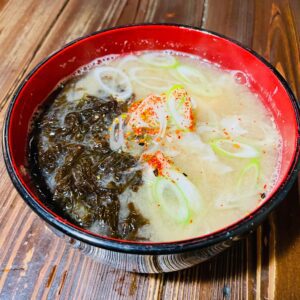
The photo below is a quote from the Ministry of Agriculture, Forestry and Fisheries’ “Our Regional Cuisines“.
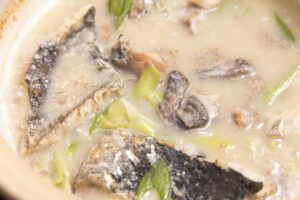
By the way, Yamagata Prefecture’s cuisine is not selected for the “Local dishes loved by the nation” by the Ministry of Agriculture, Forestry and Fisheries.
“100 selections of local dishes” and “Local dishes loved by the nation” are selected by the Ministry of Agriculture, Forestry and Fisheries.
In addition, I could eat Yamagata Prefecture’s local cuisine included “soy sauce no mi,” “Tama-konnyaku (ball konjac),” “Karakai-ni,” “Hatahata (sailfin sandfish),” and “Koi no Uma-Ni”.
“Karakai” is a dried product in which the cartilage is dried with the fins of rays (Kasube).
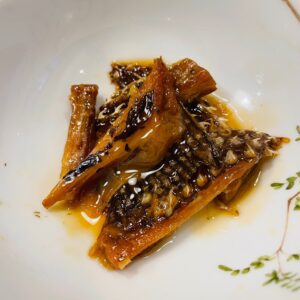

“Koi no Uma-Ni” is a local dish of Yamagata prefecture that is made by cutting carp into slices and boiling them with sugar, soy sauce, and sake.

“Warabi no Ippon-zuke (Pickled bracken)” is also a local dish of Yamagata prefecture. Yamagata Prefecture is the largest producer of bracken in Japan, and its market share exceeds 50%. I love bracken, so I enjoyed the pickled bracken.

I was able to eat Shinjo City’s famous “Torimotsu Ramen” at the “Issaan Branch”, the ramen shop that originated. The parts used for “Torimotsu ramen” are the heart, gizzards, ovary, etc. called red motu. “Torimotsu Ramen” at “Issaan Branch” is a perfect balance of light soy sauce soup and “Torimotsu”. It’s a very easy-to-eat and nostalgic ramen, and when I came to Shinjo, I wanted to try “Torimotsu ramen” again.

In this way, on this trip, I was able to eat various local dishes and local gourmet foods in addition to the “100 selections of local dishes” and “Local dishes loved by the nation” selected by the Ministry of Agriculture, Forestry and Fisheries.
Yamagata Prefecture is a prefecture that boasts of gastronomy and delicious sake, which is called “Yamagata, the best gastronomic and best sake prefecture in Japan.” There is even a homepage called “Oishii (Delicious) Yamagata“. I also think that Yamagata Prefecture’s food and sake are very delicious. The names of the airports in Yamagata Prefecture are “Oishii (Delicious) Yamagata Airport” and “Oishii (Delicious) Shonai Airport”, and both airports are appealing to Gourmand Prefecture.
In addition, Tsuruoka City, Yamagata Prefecture is the only city in Japan that has been certified as a “UNESCO Creative City of Gastronomy“. In Tsuruoka City, there are many seafood such as seafood from the Sea of Japan (such as cherry salmon and cold), mountain food such as edible wild plants, edible fungus. In addition, Tsuruoka City is blessed with many ingredients such as rice, bamboo shoots, and dadacha beans from the Shonai Plain.
Buddhist cuisine (vegetable food) as a sacred place for training is also famous. Tsuruoka City is also the birthplace of school lunches in 1889.
In fact, Tsuruoka City is very large and boasts the 7th largest municipality in Japan and the 1st largest area in the Tohoku region (source wikipedia, 2015). I am convinced that the ingredients are abundant.
2. Seasonal “PRIDE FISH” eaten in this Japanese itinerary
Yamagata Prefecture: Northern shrimp
“PRIDE FISH” in Yamagata Prefecture is “Northern shrimp” (season: December-January). I could eat “Northern shrimp” at “Izakaya Seigo” in Tsuruoka City.
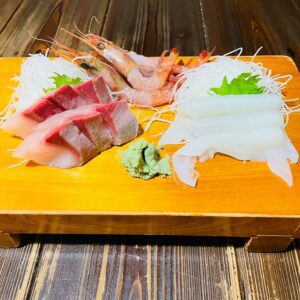
I cound eat the sushi of Gasa-ebi shrimp (standard Japanese name Kurozako shrimp) from Shonai beach. It was sweet and plump and very delicious.

Yamagata Prefecture announces only four types of “PRIDE FISH” even in a year. The “Kan dara (Cold cod)”, “Hatahata (sailfin sandfish)” that I ate this time and spring “Cherry salmon” are special fishes of Yamagata prefecture, so I think they can select as “PRIDE FISH”. As mentioned earlier, Yamagata Prefecture is a prefecture that boasts of “Yamagata, the best gastronomic prefecture in Japan”, but it is a pity that there are few “PRIDE FISH”.
“PRIDE FISH” is selected by Japan Fisheries Co-operative.
3. Travel precautions (local trains) for itinerary in Japan
I write the same thing every time, but it’s important, so I repeat it. This time as well, the rule of travel is an environment-friendly trip that uses only public transportation including rental bicycles.
Again, this is a reconfirmation, but traveling by public transport has far less CO2 emissions than traveling by car. For example, according to data from the Ministry of Land, Infrastructure, Transport and Tourism, CO2 emissions when one person travels 1 km are 130 g for automobiles, 98 g for aircraft (75% for automobiles), 57 g for buses (44% for automobiles), and 17 g for railways (13% for automobiles).
It was difficult to understand how to get on and off the one-man operated train this time as well. “JR Yamagata Line” (I ride from Oishida Station to Shinjo Station), “JR Rikuu West Line” (I ride from Shinjo Station to Amarume Station), JR Uetsu Line (I ride from Amarume Station to Tsuruoka Station, etc.) were a one-man operated train.
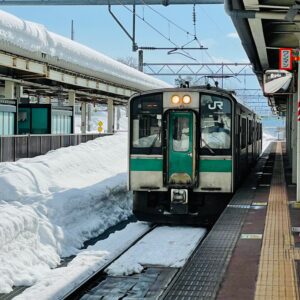
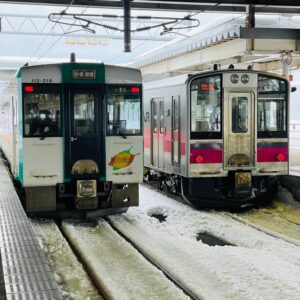
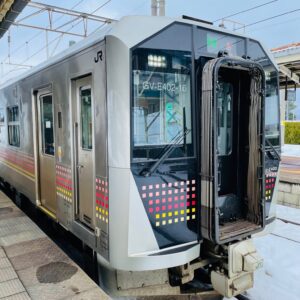
When getting on and off a one-man operated train, you need to press a button to open the door. When you get on the train, take a numbered ticket, and when you get off, put the numbered ticket and money in the fare box and get off. At “Uzen-Oyama Station”, which is the closest station to Kamo Aquarium, a machine to take numbered tickets was installed in the waiting room.
There was a poster in the car about how to get on and off, but it was only in Japanese. Railroad operators and tourist associations should be responsible for providing guidance in foreign languages.
In the case of a one-man operated train, it is safe to always get on the first car. Be sure to remember the train boarding / alighting rules when traveling in rural areas of Japan. However, it depends on the railway operator whether you ride from the front door or the rear door of the first car.
Please see the detailed notes written on each travel day.
4. Travel in a light style
Again, I sent my clothes and power cord to my accommodation in advance for this trip, and enjoyed the “luggage free trip” every day. After all, it is very easy to travel in a light style like taking a walk. Being able to act immediately after arriving by train or plane is important for effective use of time.
Also, like this time, when it snows, transporting the suitcase becomes many times more difficult than on a road without snow. I want you to travel as “luggage-free trip” in winter. Again, on the last day of the trip, I sent the clothes I wore during the trip to the laundry agent and did not have to do the laundry. I want everyone to experience the comfort of “luggage-free trip”.
5. January 25 (Tuesday) Day 1
I arrived at Yamagata Airport and took an airport bus to Yamagata City.
After arriving in Yamagata City, I first took a bus to the “Yamagata Prefectural Museum Educational Resources Museum”.
The building of Yamagata Prefectural Museum Educational Resources Museum was built in 1901 and is designated as a national important cultural property.
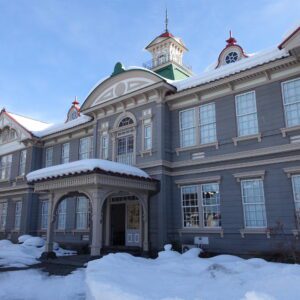
The old wooden Yamagata teacher school auditorium is a designated tangible cultural property of Yamagata Prefecture. The design under the roof is wonderful.
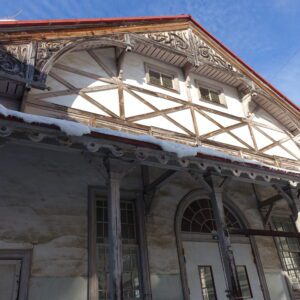
I went to “Yamagata Prefecture Local Museum “Bunshokan”“, which is about a 10-minute walk from Yamagata Prefectural Museum Educational Resources Museum.
The current building of “Yamagata Prefecture Local Museum “Bunshokan”” was completed in June 1916. The former Prefectural Office and the Assembly Building are connected by a corridor. Both buildings are national important cultural properties.
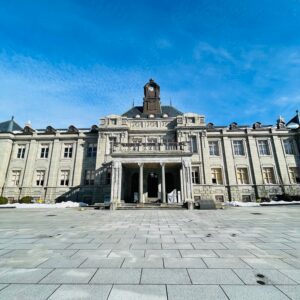
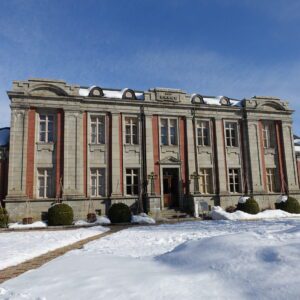
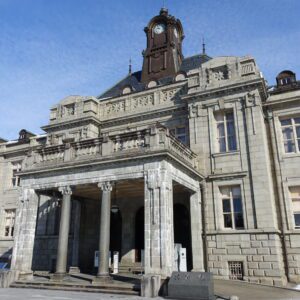
Kajo, Yamagata Castle, which is about a 20-minute walk from “Yamagata Marugoto-kan Beni-no-kura,” began when Shiba Kaneyori (the first Mogami clan) built the castle in 1357. Mogami Yoshiaki, the first feudal lord of the Yamagata domain, developed the castle. It is a nationally designated historic site and one of the 100 Fine Castles of Japan established by the Japan Castle Association.
The size of Yamagata Castle is wider than the national treasure Himeji Castle (Hyogo Prefecture), and it seems that it was the fifth largest in Japan. However, it was a castle without a castle tower from the beginning.
At the time of my visit, the Honmaru Ichimonji-mon gate was a beautiful scene with snow.

Yamagata City Local History Museum (former Saiseikan Hospital) was built in 1878 as Yamagata Prefectural Hospital. It was relocated and restored in Kajo Park in 1969. It is currently used as the Yamagata City Local History Museum.
It is a beautiful wooden three-story building, and was evaluated as a masterpiece of pseudo-Western style architecture in the early Meiji era, and was designated as a national important cultural property. The first floor is a donut-shaped and very characteristic building.
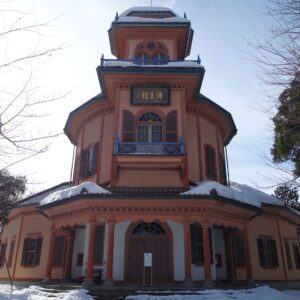
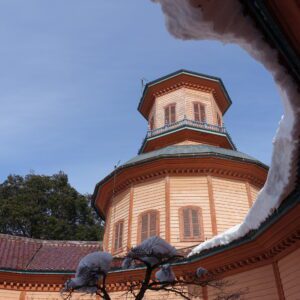
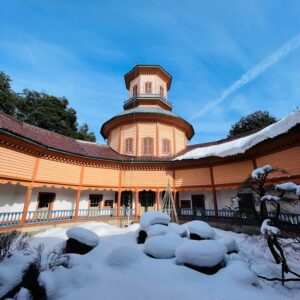
Visiting the inside of the Yamagata City Local History Museum is free of charge.
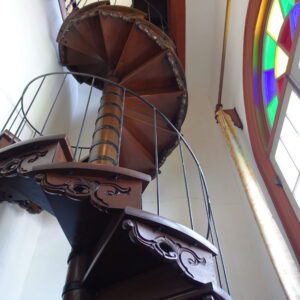
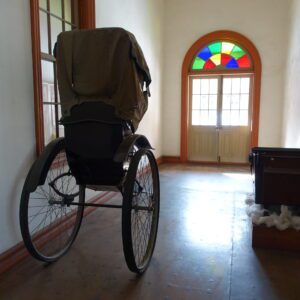
I headed to Ginzan Onsen by Shinkansen and inn shuttle bus.
Ginzan Onsen is a hot spring located in Obanazawa City, Yamagata Prefecture, and the nearest station is Oishida Station. Oishida Station is a stop on the Yamagata Shinkansen, so you can access it from Tokyo Station in less than 3 hours and 30 minutes without changing trains. From Oishida Station, you can reach Ginzan Onsen in 30 minutes by the free shuttle bus from each inn.
It has been in the limelight because it became the stage of the NHK TV series “Oshin”, and has attracted many tourists from Japan and abroad. Notoya Ryokan is said to be a model inn of “Spirited Away”.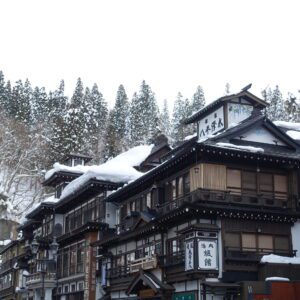
The history of Ginzan Onsen begins when Ginzan became a hot spring resort after the Ginzan (silver mine) closed in 1689. After that, the hot spring town was destroyed by the great flood of 1913, but the scene of the current hot spring town was created from the end of the Taisho era to the beginning of the Showa era (late 1920s to early 1930s).
The beautiful scenery of the Taisho Roman attracts many tourists. Especially, I think the night view of Ginzan Onsen is the most beautiful.

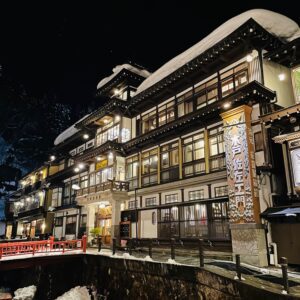
The Notoya Ryokan where I stayed this time is a nationally registered tangible cultural property. NHK’s “Oshin” was also filmed at Notoya Ryokan.
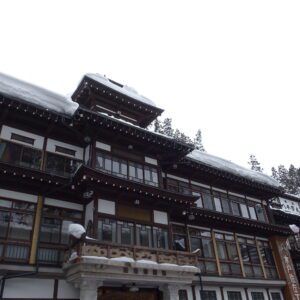
In addition, there are many inns in Ginzan Onsen that are decorated with “trowel picture”, which are reliefs made from plaster. It was a fun hot spring town just to take a walk while looking at the trowel picture.
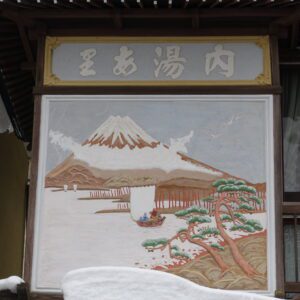
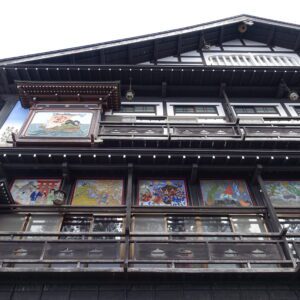

Meals
I had ekiben on the Yamagata Shinkansen. I like traveling by train, and I love the ekiben on the train. I ate “Beef Domannaka”. It’s a specialty of Yonezawa, but I bought it at Yamagata Station because it’s my favorite ekiben. “Beef Domannaka” is a well-known ekiben nationwide that was selected as the No. 1 ekiben in East Japan in 2013. I was very satisfied with the ekiben with beef soboro and beef simmered on top of Yamagata prefecture’s brand rice “Domannaka”.
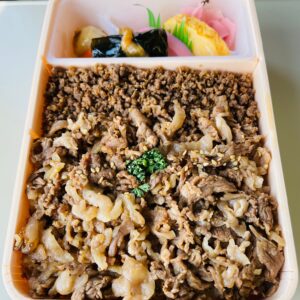
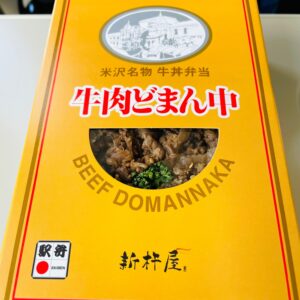
The ekiben that I ate while watching the snowy scenery from the train window of the Yamagata Shinkansen was the best.

Yamagata Prefecture is famous for sake production and is ranked 6th in the ranking by prefecture. There are many famous sakes such as “Juyondai”, “Kudokijozu”, “Jokigen”, and “Hatsumago”. Yamagata Prefecture is also developing “Dewa San San” and “Dewa no Sato”, which are suitable rice for sake brewing. “Koten” in the photo below is a local sake from Otokoyama Sake Brewery (Yamagata City) that uses “Dewa San San” as the raw material rice. I bought “Koten” at Yamagata Station.

“Yamagata Masamune” of Mitobe Sake Brewery (Tendo City), which uses Okayama Prefecture’s Omachi as the raw material rice, was also a delicious sake of “Usunigori”. There was also the original Ginzan Onsen sake from “Yagihashi Shoten”.
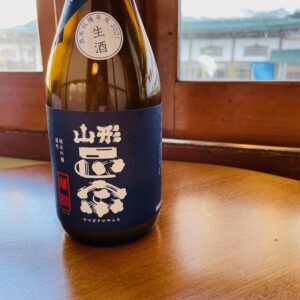

I had dinner in the room of Notoya Ryokan. It was a very satisfying dinner with a huge amount. If you look at the items in the picture below, you can understand the large amount of dinner. I think many people can’t eat it. I’m worried that many people won’t be able to eat and will have a lot of leftover food.

The shabu-shabu of Obanazawa beef and Yonezawa pork was the best.
The climate nurtures the deliciousness of Obanazawa beef. Obanazawa City, where Ginzan Onsen is located, rises to nearly 40 degrees Celsius in summer and becomes a harsh environment of -10 degrees Celsius or less in winter. Cows naturally acquire fat in order to overcome this harsh environment of temperature difference. This finest fat is the source of the deliciousness of Obanazawa beef. According to the Obanazawa Beef Promotion Council, Obanazawa beef is only offered at 4 inns at Ginzan Onsen.
Yonezawa pork was also delicious pork with sweet fat. “Pork” is the third largest agricultural output in Yamagata prefecture after “rice” and “cherries”. There are “Yonezawa Pork Ichiban Sodachi”, “Tengen Pork”, “Yonezawa Sangen Pork”, etc. in the Yonezawa area.
 The Dengaku of char was a little sweet, but I’m glad I was able to eat the char for the first time in a while.
The Dengaku of char was a little sweet, but I’m glad I was able to eat the char for the first time in a while.

The duck soup was also hot and delicious.

Important points
I didn’t have any problems on the first day.
6. January 26 (Wednesday) Day 2
I left Ginzan Onsen by the shuttle bus of Notoya Ryokan, arrived at Oishida Station, and headed for Shinjo Station.
I arrived in Tsuruoka city and enjoyed sightseeing in Tsuruoka city. Most of the sightseeing spots in Tsuruoka City are concentrated around the Tsurugaoka Castle Ruins. It’s about a 20-minute walk from Tsuruoka station, but this time I moved by bus.
Depart Tsuruoka Station at 13:48, Yunohama Onsen Line [via Zenpoji] “bound for Yunohama Onsen”, arrive at Ginza Dori at 13:52, fare Yen 200
Heishindo Merchant House is a national important cultural property. The Kazama family developed as a merchant of the Shonai domain and became the number one wealthy merchant in Tsuruoka. Heishindo Merchant House was built in 1896 on the site of a samurai residence. Unfortunately, it was closed in winter (December 1st to April 9th), so I couldn’t visit the inside of the house.
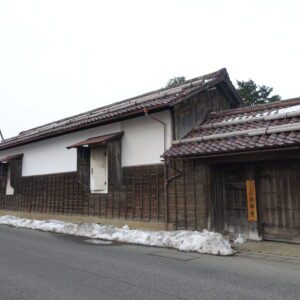
Tsuruoka Catholic Church is a Romanesque church building built in 1903. It is a national important cultural property.
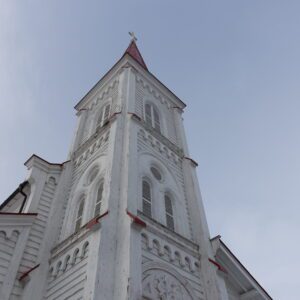
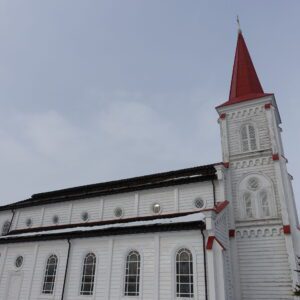
In the Tsuruoka Catholic Church, there is a “Black Virgin Mary Statue” that is unique to Tsuruoka in Japan. The little Christ of the Virgin Mary is also a black statue. I had no prior knowledge, so I was surprised at the black Virgin Mary and Christ statues. The “Black Virgin Mary Statue” was donated by the Delibrand Monastery in Normandy, France, to commemorate the construction of the church.
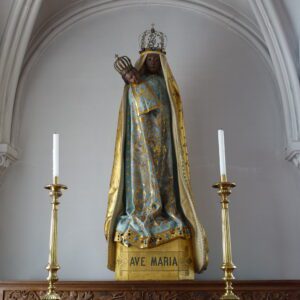
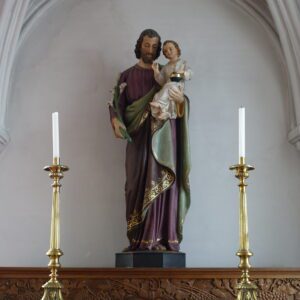
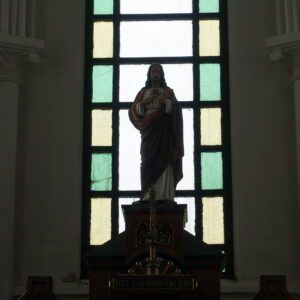
The interior of the Tsuruoka Catholic Church is also wonderful, and I think it is a highly valuable church to visit.
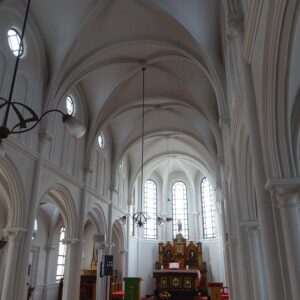

Taihokan was built in 1915 to commemorate the throne of Emperor Taisho. It was used as a product display hall at the beginning of the opening and as a municipal library after the war. The contrast between the red dome and the white walls is very beautiful.
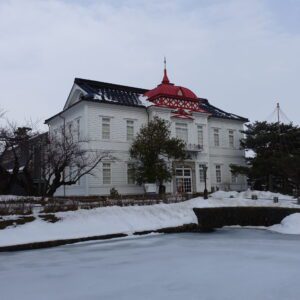
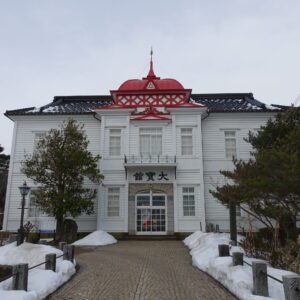
The hanachozu (chozubachi with flowers) at the Shonai Shrine seemed to be maintained every day and was very beautiful.
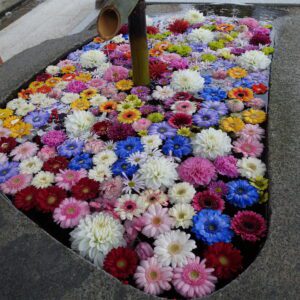
The “SUIDEN TERRASSE HOTEL” where I stayed on the 26th and 27th was a beautiful and calm hotel. This hotel is equipped with a library and sake lounge, making it an ideal hotel for long-term stays.
Designed by famous architect Shigeru Ban.

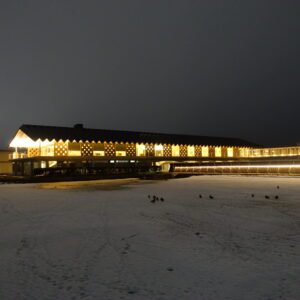

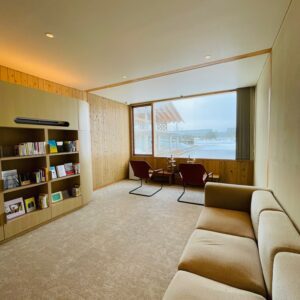
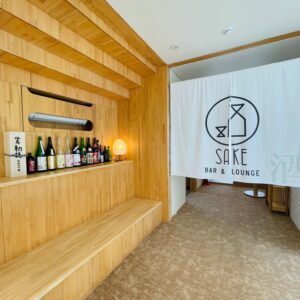
Meals
I had breakfast at the restaurant of Notoya Ryokan. I have always loved breakfast at hot spring inns. Breakfast at a hot spring inn has many side dishes, and I feel always happy. There were many types of breakfast at Notoya Ryokan, and I was very satisfied.

After sightseeing in Tsuruoka city, I had dinner at “Izakaya Seigo”. The counter of “Izakaya Seigo” was deep, spacious and cozy. I love the deep counter izakaya.
At “Izakaya Seigo”, I had assorted sashimi, grilled shiitake mushrooms and shishito green pepper, grilled squid, motsu-ni (gut stew), sashimi of cod milt, and “Dongara-jiru (cod soup)”.
“Dongara-jiru (Chunky cod stew)” is a local dish that represents the Shonai region and has been selected by the Ministry of Agriculture, Forestry and Fisheries as one of the “100 Best Local Cuisine”. Tsuruoka City and Sakata City hold the “Japan Sea Cod Festival” every year. You can’t see the cod in the soup in the photo, but in reality, the cod was lumpy and it was delicious “Dongara-jiru (Chunky cod stew)”. “Dongara” is a word that refers to “the offal of a fish”, and “Dongara-jiru (Chunky cod stew)” is made from “the offal of a cod”.

At Shonai beach, Pacific cod is a representative fish of winter, and the aforementioned “Dongara-jiru (Chunky cod stew)” is famous. Shirako (milt of cod) is also delicious because they can catch delicious cod. Of course I ordered it because I love the trolley-textured milt. It was the most delicious milt that goes well with sake from the Shonai region.
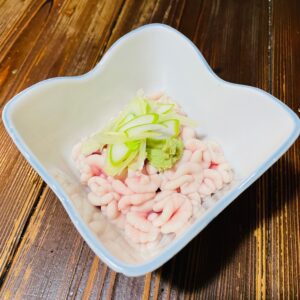
Assorted sashimi, grilled shiitake mushrooms and shishito green pepper, grilled squid, motsu-ni (gut stew) were all delicious and very satisfying.

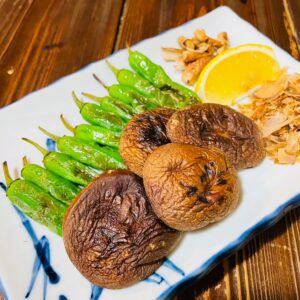

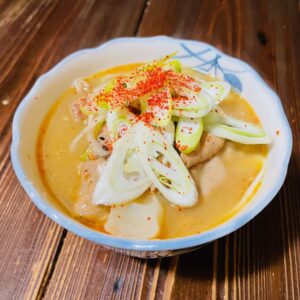
Important points
Taxi is the main means of transportation from Tsuruoka Station to SHONAI HOTEL SUIDEN TERRASSE. A taxi from Tsuruoka Station takes less than 10 minutes and costs about Yen 1,000.
However, four airport shuttle buses run daily from Tsuruoka Station to the “Science Park” bus stop in front of SUIDEN TERRASSE. The departure time of Tsuruoka Station is 5:57, 7:12, 11:24, 16:17. Arrival at “Science Park” is 6 minutes later. The fare is Yen 330.
The airport bus will be suspended if the flight is cancelled.
From Shonai Airport, the airport bus departs from Shonai Airport about 10 minutes after the arrival of the flight. Flight arrival times are 8:10, 12:05, 16:55 and 21:20. Take the airport shuttle bus and get off at the “Science Park” bus stop to reach SUIDEN TERRASSE. The fare is Yen 720.
This route does not appear in Google map or Yahoo route information. However, since I actually used it, anyone can use it.
7. January 27 (Thursday) Day 3
In the morning, I left the Suiden Terrasse Hotel and headed for Mt. Haguro via Tsuruoka Station.
The Five-Story Pagoda of Mt. Haguro is the only national treasure building in Yamagata Prefecture. I visited the Five-Story pagoda a few years ago in early summer. However, this is my first visit in winter.
Mt. Haguro is one of DEWA SANZAN (the three mountains of Dewa, Mt. Gassan and Mt. Yudono) and is a mountain of Shugendo (Japanese mountain asceticism incorporating Shinto and Buddhist concepts). You can reach the summit of Mt. Haguro by bus.Considering the timetable of the bus, it is more efficient to visit the five-storied pagoda first.
To get to the Five-Story Pagoda, enter from Zuishinmon. The inside of the Zuishinmon is the sanctuary of DEWA SANZAN.
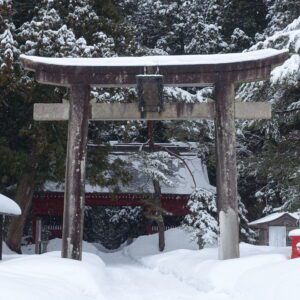
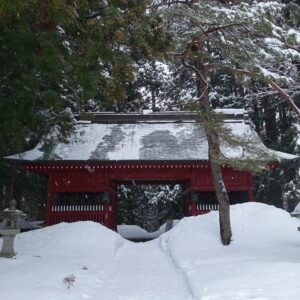
After passing through the Zuishinmon, you will reach a downhill called Mamakozaka. When you go down Mamakozaka, there are several subordinate shrines.
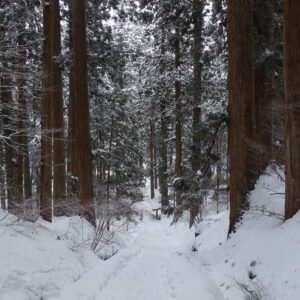
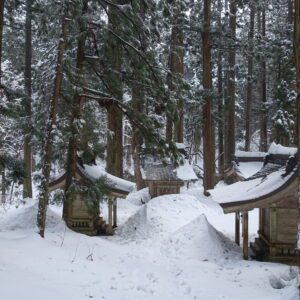

After crossing the subordinate shrines, you will see Suga Waterfall on your right. The river downstream of Suga Waterfall was covered with snow and was a very beautiful view.
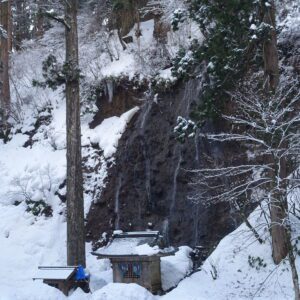
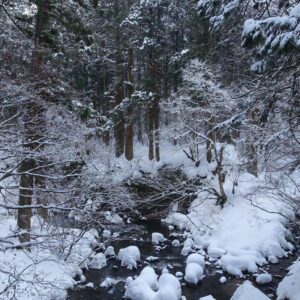
After crossing Suga Waterfall, you will climb a little uphill, and after passing the snow-covered lanterns, you will see “Jiji-sugi (Grandfather cedar)” and the Five-Story Pagoda. “Jiji-sugi” is a natural monument of a country over 1,000 years old.
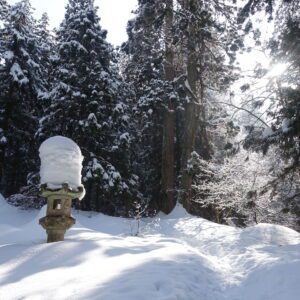

The Five-Story Pagoda is said to have been built by Taira no Masakado during the Jōhei era (931-938) in the middle of the Heian period. The current Five-Story Pagoda is said to have been rebuilt by Masauji Muto (Masauji Daihoji), the lord of Shonai about 600 years ago.
The height of the Five-Story Pagoda is about 29.2 meters. When I first saw the Five-Story Pagoda, I was wondering how the Five-Story Pagoda was built in such a mountain and was very impressed. The Five-Story Pagoda in the snow this time also stood beautifully in a sacred atmosphere, which was wonderful.

The way back from the Five-Story Pagoda was difficult because it was a climb up the Mamakozaka to Zuishinmon. Even though it was a cold day, I got sweaty.
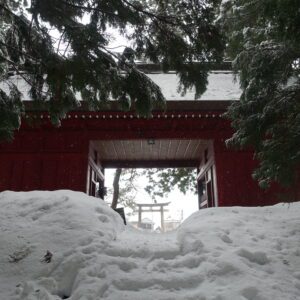
I took a bus to the summit of Mt. Haguro.

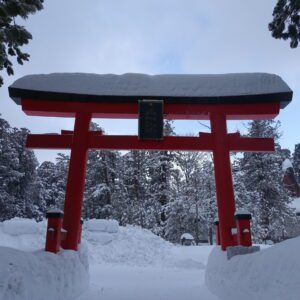
If you go through this torii gate, you will find the Sanjin Gosaiden and the Bell Tower. Both are national important cultural properties. The Sanjin Gosaiden is a thatched wooden building that enshrines the three gods of Mt. Gassan, Mt. Haguro, and Mt. Yudono, which was completed in 1818. The thatched roof is 2.1m thick and is one of the three major thatched roofs in Japan (the others are Agishi Honseiji Temple in Ishikawa Prefecture and Shoboji Temple Main Hall in Iwate Prefecture).
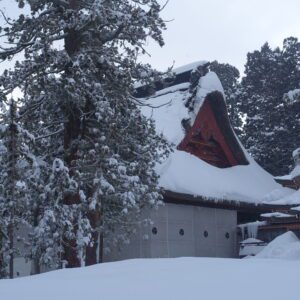
The height of the Sanjin Gosaiden is 28m, which is comparable to the Five-Story Pagoda. I was surprised at its huge size. There is a cover due to the snow, so you cannot see the details from the outside, but you can go inside and worship.
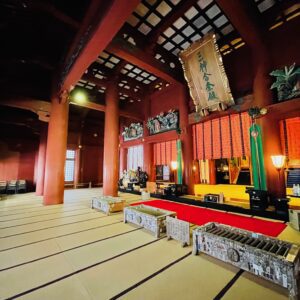
The bell tower is a thatched, gabled roof building. It was rebuilt in 1618 in the early Edo period. It is the second oldest building on Mt. Haguro after the national treasure Five-Story Pagoda. The bell was made in 1275, and it is said that after the Mongol invasion (Battle of Bunei, 1274), the Kamakura Shogunate felt the spiritual power of Mt. Haguro and dedicated it to Mt. Haguro.
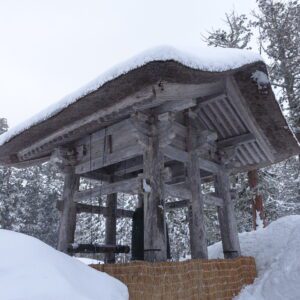
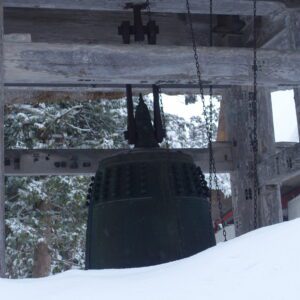
After arriving at Tsuruoka Station from Mt. Haguro, I had lunch and took a taxi to Kamo Aquarium. It takes about 30 minutes by taxi from Tsuruoka Station to Kamo Aquarium, and the fare is about Yen 4,000. There is one bus every two hours from Tsuruoka Station to Kamo Aquarium, but this time I used a taxi to save time.
This is my second visit to Kamo Aquarium. Kamo Aquarium is known by the nickname of “The Dream House of Jellies”, and there are more than 60 types of jellyfish on display. It was certified as a Guinness World Record for the number of types of jellyfish. Although the Kamo Aquarium was in a period of poor management, the exhibition of jellyfish made it one of the leading tourist destinations in the Shonai region, attracting more than 500,000 people annually.
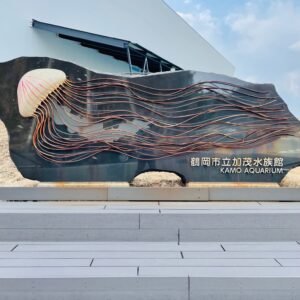
By the way, Kamo Aquarium started exhibiting jellyfish because of an accidental occurrence of jellyfish in a coral aquarium. The Green Fluorescent Protein (GFP) discovered by Osamu Shimomura, who won the Nobel Prize in Chemistry, was derived from Aequorea victoria. It was reported that the Kamo Aquarium was breeding Aequorea victoria, and it seems that the number of visits has increased dramatically.
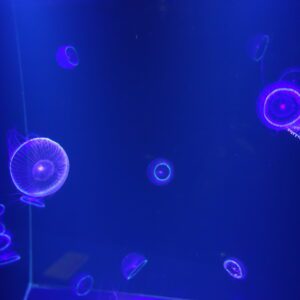
When you enter the Kamo Aquarium, various fish and shellfish are displayed before the jellyfish exhibition. Mainly fish and shellfish caught in Shonai beach.
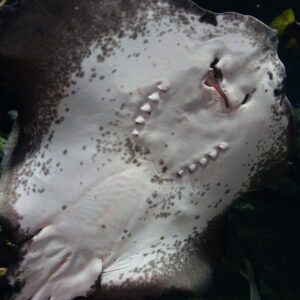

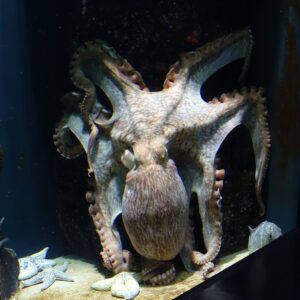
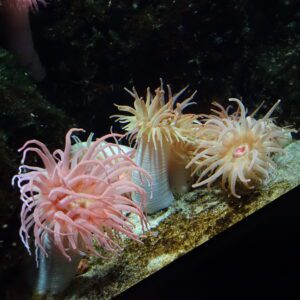
At Kamo Aquarium, the exhibition space for jellyfish is called “Kuranetarium”. The approximately 10,000 Aurelia floating in the 5-meter-diameter aquarium “Jellyfish Dream Theater” is a masterpiece. The other jellyfish tanks also feel like space.
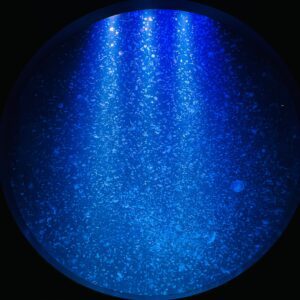
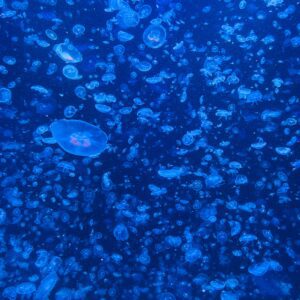
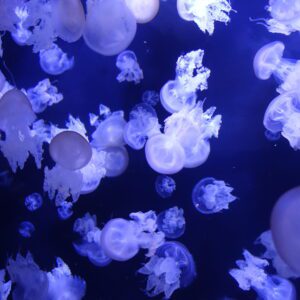
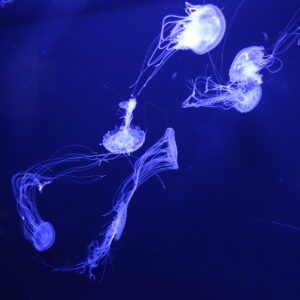
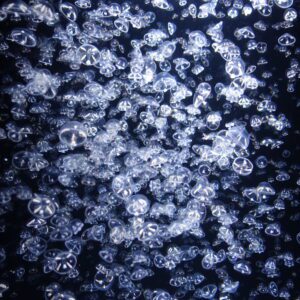
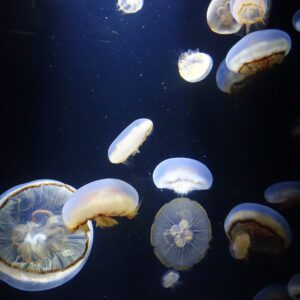
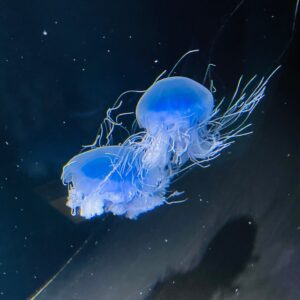
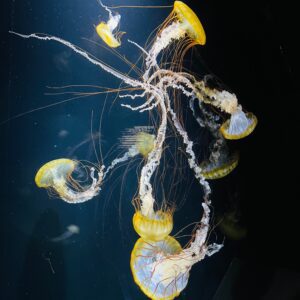
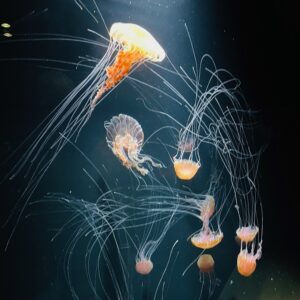
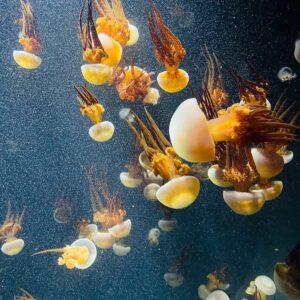
There are also sea lions and seals in the Kamo Aquarium. A harbor seal turned to me.

Meals
I had breakfast at the restaurant of SUIDEN TERRASSE Hotel. Breakfast at SUIDEN TERRASSE is a Japanese buffet with about 30 items. Although it is a buffet, the staff members kindly served me with rice, miso soup, and Dongara-jiru (Chunky cod stew) .
The Japanese buffet at SUIDEN TERRASSE is characterized by offering local ingredients and many local dishes. At the breakfast I had so many local dishes of the Shonai region and Yamagata prefecture. I ate Shonai Asatsuki (spring onion) with vinegar miso, Yamagata prefecture pholiota nameko soy sauce, Shonai beach salt-grilled blackthroat seaperch, simmered Shonai pork, Yamagata specialty Tama konnyaku (ball konjac), Shonai pork sausage, local dish salt natto, soy sauce no mi, Dongara-jiru (Chunky cod stew), Shonai rice (Tsuyahime, Yukiwakamaru), Chokai Kogen yogurt, etc.

At the restaurant, I enjoyed the view of Mt. Chokai and had a good breakfast from the morning.

After returning from Mt. Haguro, I ate shio ramen at “Sengoku-ya” for lunch. The owner of “Sengoku-ya” was training at “China Sobaya”, Minoru Sano (deceased person), who is famous in the ramen world. “Sengoku-ya” is about a 5-minute walk from Suiden Terrace. I ordered the most popular “Shio ramen noodles” (Yen 950).

I took a taxi from Kamo Aquarium to Uzen-Oyama Station and took a train to Sakata Station. Uzen-Oyama Station is the closest station to Kamo Aquarium.
I went to Sakata station to have dinner at the famous sushi restaurant “Sushi Koise” in the Shonai region. “Sushi Koise” has been selected as one of the 100 famous tabelog restaurants.
At “Sushi Koise”, I ate assorted sashimi, grilled soy sauce marinated Hatahata (sailfin sandfish), blowfish sashimi, grilled blowfish milt, and cod milt sashimi.
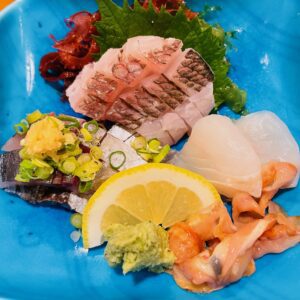
Hatahata (sailfin sandfish) is famous in Akita prefecture, but it can also be caught in Yamagata prefecture, which is located next to Akita prefecture. Yamagata Prefecture has the fifth largest catch of Hatahata (sailfin sandfish) in Japan. As I described in the Aomori / Yamagata trip in December, the fishing season for Hatahata (sailfin sandfish) in Akita prefecture is very short, about one month in December. On the other hand, Hatahata (sailfin sandfish) in Yamagata Prefecture has a long fishing season, and the seasons are June and September to December.
The size of Hatahata (sailfin sandfish) is smaller in Yamagata prefecture and larger in Akita prefecture. This is because Akita Prefecture does not fish until it grows larger. On the other hand, Hatahata (sailfin sandfish) in Yamagata Prefecture fishes before the female’s nutrition is taken up by the eggs, so it is small but has a good taste.

In addition, “Hatahata no Yuage”, which is eaten by adding soy sauce to Hatahata (sailfin sandfish) boiled in a pot, has been selected as “Our Regional Cuisines” by the Ministry of Agriculture, Forestry and Fisheries.
The egg called Buriko was also very delicious with a bubble wrap texture. By the way, the reason why Hatahata’s eggs are called “Buriko” is that when Hatahata was overfished and the fishing was prohibited, they secretly ate it by deceiving them as “Buri’s ko (eggs of Japanese amberjack)”.
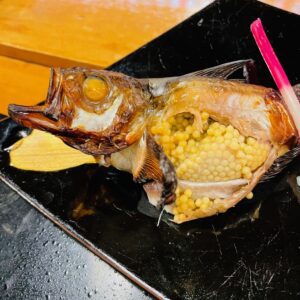
Blowfish is also caught in Yamagata Prefecture, and the quality of blowfish is said to be highly evaluated in the Toyosu market in Tokyo. The blowfish sashimi was refreshing and delicious. In particular, the shirako-yaki of tiger puffer was the best with its sticky texture.

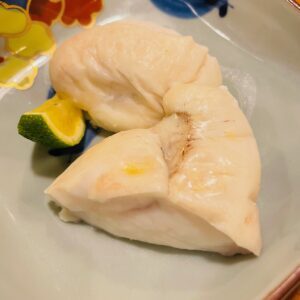
I ate cod milt sashimi at “Izakaya Seigo” the day before, but since it’s the season for cold cod, I ordered it at “Sushi Koise”. Cod milt sashimi is my favorite and it was in season so it was the best.

After enjoying the Tsumami (snacks) and sake, I ordered the sushi “Omakase Nigiri” (Yen 3,300 ), which uses a lot of local fish. Especially, the sushi of Gasa-ebi shrimp (standard Japanese name Kurozako shrimp) from Shonai was sweet and plump and very delicious. The seasonal halfbeak from Shonai was also light and delicious. Everything else was the best sushi and it was a very satisfying dinner.


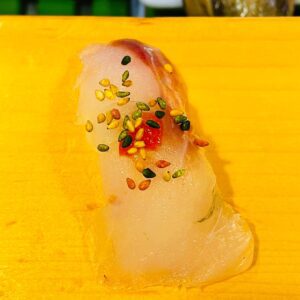





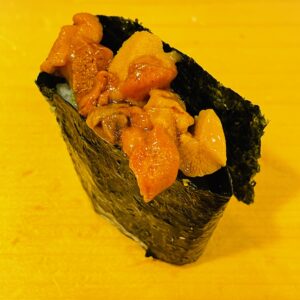
Important points
At the Tsuruoka City Tourist Information Center in front of Tsuruoka Station, you can purchase a one-day bus ticket for Shonai Kotsu for Yen 2,000 (C Tsuruoka all area). It is advantageous to use a one-day bus ticket for a round trip from Tsuruoka Station to Mt. Haguro. The normal round-trip fare from Tsuruoka Station to Mt. Haguro is Yen 2,500.
There are 10 trains a day from Tsuruoka Station to Mt. Haguro (8 trains a day on weekends and holidays), which is very convenient. All flights operate to Haguro Zuishinmon and “Ideha Cultural Museum”, which are bus stops to get off to the five-storied pagoda. However, the number of trees up to the summit of Mt. Haguro will be reduced to 5 in summer and 3 in winter. Therefore, the order of going is important in order to go to the five-storied pagoda and the mountaintop together. I think the most efficient order is to go to the five-storied pagoda first, and then take a bus to the top of the mountain.
There are 8 trains a day from Tsuruoka Station to Kamo Aquarium (5 trains a day on weekends and holidays). In addition, there are 9 trains a day from Kamo Aquarium to Tsuruoka Station (5 trains a day on weekends and holidays). Therefore, it is quite possible to go to Kamo Aquarium by bus. Kamo Aquarium costs Yen 760 one way, but if you go back and forth by bus, it is advantageous to use a one-day ticket of Yen 1,000 (B Yunohama / Yutagawa area).
If you show the ticket stub that you used to enter the Kamo Aquarium, you can use it as a coupon at stores and facilities in Tsuruoka City. Since it can be used at more than 10 stores and facilities, it is more likely that you will get a good deal if you have a ticket stub.
8. January 28 (Friday) Day 4
The Chido Museum has three buildings that are national important cultural properties (Former Nishitagawa District Office, Former Shibuya Household, and Former Tsuruoka police Station).
The Former Nishitagawa District Office is a pseudo-Western style building built in 1881.

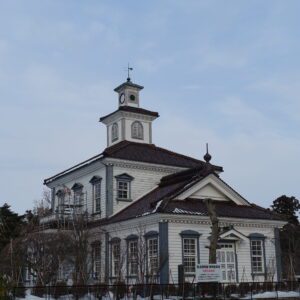
The Former Shibuya Household is a private house built in 1822. Originally located in a mountain village at the foot of Mt. Yudono, DEWA SANZAN, it was relocated to this area.
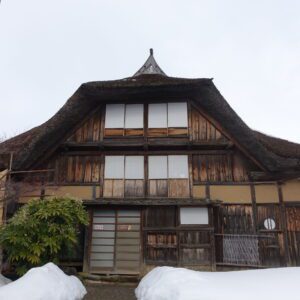
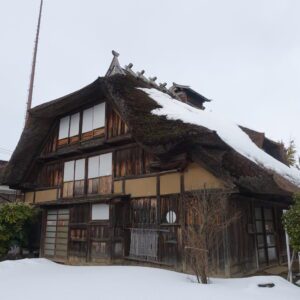
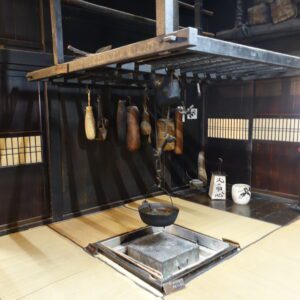
The Former Tsuruoka Police Office is a pseudo-Western style building built in 1884. It is a wonderful building with its majestic appearance typical of a police building and unusual light blue walls.
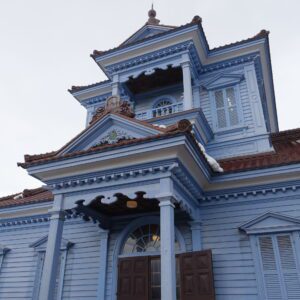
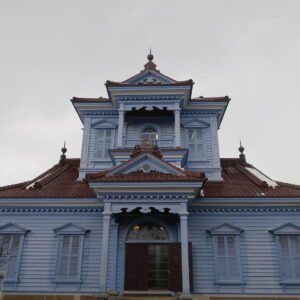
The Goinden (Retirement Residence of the Shonai Sakai lord) was built by the 11th Shonai feudal lord Sakai Tadaaki. The Nakayashiki in Edo was dismantled, and a part of it was relocated to the site of Tsurugaoka Castle Sannomaru’s palace in 1863.
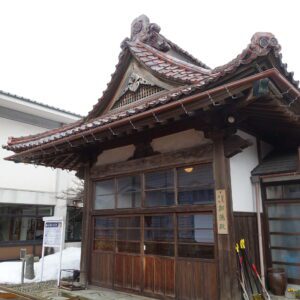
The Shonai Clan School Chidokan is a nationally designated historic site. The name of Chidokan comes from a passage in the Analects.
Chidokan is a school founded in 1805 by the 9th generation of the Sakai clan of the Shonai clan, Tadanori, to promote the administration of the clan.

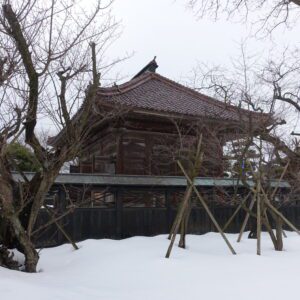

Meals
I had a ramen as a brunch at the ramen shop “Konpiraso” in Sanze.
I arrived at “Konpiraso” at 10:50, but the numbered ticket was already 29th. “Konpiraso” is open at 11 o’clock, but it seems that the store will open shortly before it opens, and it was already full.
“Konpiraso” is a very popular ramen shop. I arrived at “Konpiraso” at 10:50, waited for 50 minutes, and was able to take a seat at 11:40.
I ordered the light taste of “Soy sauce taste ramen noodles”, Ajitama (soft-boiled egg marinated in soy and mirin), and a large serving (free of charge) for 850 yen. I always ask for “Kotteri (rich taste, more oil)”, so I ordered “Assari (light taste)” for the first time this time. However, I was overwhelmed by the “Kotteri” that I had eaten before, so I regretted that “Assari” was not enough.

As it is still the case, “Konpiraso” is an inn. The area around “Konpiraso” is the Sanze beach, where many guests stay in the summer, but during the winter there was a problem that the number of guests was small. The shop owner started the current ramen noodle shop to attract customers in winter. At first, it seemed that it was quite difficult to attract customers, but now it has become a very popular ramen shop as mentioned above. The entrance to Konpiraso is the inn itself.

After sightseeing in Tsuruoka city, I took a break at “Fruit Shop Aomoriya” near Tsuruoka station. “Fruit Shop Aomoriya” is a fruit shop that the first owner started this fruit shop to bring apples from Aomori prefecture to Tsuruoka city, Yamagata prefecture. You can enjoy drinks such as cakes and coffee in the store.
I ordered a very rare tart of “Yayoihime” (a tart of Shonai strawberries “Yayoihime” and “blueberry” on rare cheese cream). Both strawberries and blueberries were delicious tart. I was convinced that it was a popular shop.
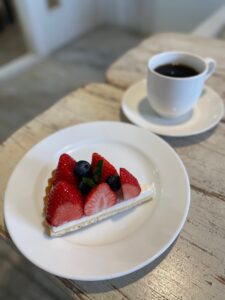
After arriving at Haneda Airport, I had dinner at the grilled offal restaurant “Mitsubo” near my house. “Mitsubo” is my favorite grilled offal restaurant that I have been attending for 20 years. I eat at “Mitsubo” once a month. My favorite food at “Mitsubo” is “Liver no Bukkake negi (green onion on liver)”. It was good to end the fun trip to Yamagata with delicious grilled offal in Tokyo.
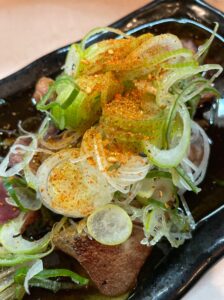
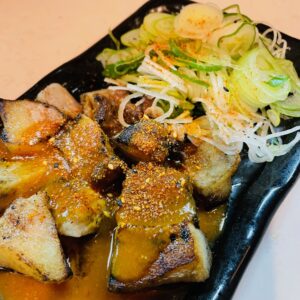
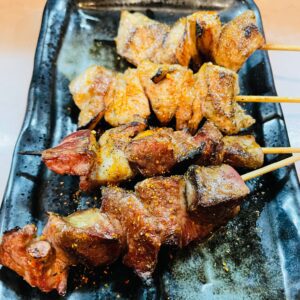
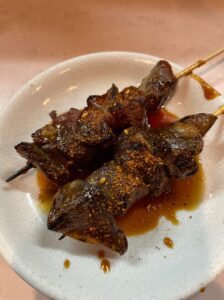
Important points
The number of transportation to the ramen shop “Konpiraso” is very small and inconvenient.
For example, from Tsuruoka Station to the nearest Sanze Station, there are only the following four public transportation systems that are ideal for Konpiraso during business hours from 11:00 to 14:00.
Depart Tsuruoka Station at 11:17, JR Uetsu Line “bound for Murakami”, arrive at Sanze Station at 10:32, about 20 minutes on foot
Depart Tsuruoka Station at 11:08, Bus Tsuruoka Atsumi Onsen Line “bound for Atsumi Sales Office”, arrive at Sanze at 11:57, about 5 minutes on foot
Depart Tsuruoka Station at 12:43, Bus Tsuruoka Atsumi Onsen Line “bound for Atsumi Sales Office”, arrive at Sanze at 13:32, about 5 minutes on foot
Depart Tsuruoka Station at 13:28, JR Uetsu Main Line “bound for Murakami”, arrive at Sanze Station at 13:44, about 20 minutes on foot
The fourth JR Uetsu Line arrive just before Konpiraso closes, so it is not realistic.
On the other hand, there are only two optimal public transportation from Konpiraso to Tsuruoka Station.
Depart Sanze Station at 11:43, JR Uetsu Line “bound for Sakata”, arrive at Tsuruoka Station at 12:00
Depart Sanze Station at 15:05, JR Uetsu Line “bound for Sakata”, arrive at Tsuruoka Station at 15:22
Considering the popularity of “Konpiraso”, I think it is difficult to make it in time for the first one. On the other hand, the second one is too late considering the business hours until 14:00.
In addition to this, there is also a way to go from the Sanze bus stop to “Atsumi Onsen”, which is the opposite direction of Tsuruoka station, and take the limited express Inaho No. 3 to return to Tsuruoka station, but the fare is Yen 2,040 per person and go at each of the above stations. Compared to that, it takes about 7 times.
In this way, in order to eat ramen at Konpiraso, it is realistic to rely on a taxi for at least the means of transportation on the way back. However, you need to be prepared for a fare of over 5,000 yen from Konpiraso to Tsuruoka city by taxi.
The only restaurant at Shonai Airport is the Tonkatsu restaurant “Hirata Farm” (located on the 3rd floor). There are two shops (Kiyokawaya and ANA FESTA) on the 2nd floor, but alcohol sales other than sake only sell one type of canned beer. Also, if you cross the baggage inspection area at the airport and enter the boarding waiting room, there is no shop (there is a vending machine). In this way, it is difficult to enjoy eating and drinking at Shonai Airport before the flight because the options are limited.
Note: The departure / arrival times, fares, admission fees, meal fees, etc. of transportation listed in the text are as of the time of writing the BLOG. Please check for yourself when you go on a trip as it may change in the future.